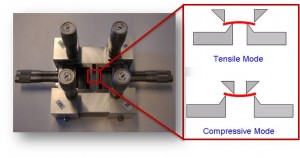Performance Enhancement of III-V FETs through Uniaxial Strain
The incorporation of mechanical strain in the channel has greatly enhanced the carrier velocity and performance of both n- and p-type Si MOSFETs. As scaling approaches the end of the roadmap, InGaAs-based FETs are receiving a great deal of attention as a potential post-Si CMOS logic technology. Just as with Si, in an effort to explore the ultimate potential of InGaAs for logic, strain is being investigated as a path to improve the performance of InGaAs FETs. In our present work, we carry out an experimental study on the potential to improve III-V FETs performance by introducing uniaxial strain into these devices.

Figure 2: Measured sub-threshold characteristics of AlGaAs/InGaAs HEMT as <110> uniaxal strain changes. The cross section of the device is shown in the inset.
To introduce controlled uniaxial strain in FETs, we designed and fabricated a mechanical apparatus (Figure 1) to bend III-V chips. This apparatus allows the application of uniaxial strain up to ±0.3% to III-V chips with a size down to 2 mm x 4 mm. Electrical measurements can be performed while the chips are bent. This experimental approach isolates well the impact of strain on device performance from other factors such as device structure change.
The devices used in our study include both n- and p-type InGaAs FETs, either supplied by industrial collaborators or fabricated by our own technology at MIT. The inset in Figure 2 shows the cross section of an AlGaAs/InGaAs high-electron-mobility transistor (HEMT) that we have already studied [1]. We found that strain significantly changes the operation of these devices, as can be seen in their subthreshold characteristics in Figure 2. In devices with more InAs in the channel [2], the channel electron mobility is found to be enhanced by tensile strain. In fact, our simulations suggest that as more InAs is incorporated into the channel, the mobility enhancement should enlarge. On the other hand, we are also studying the performance improvements in p-type InGaAs FETs, in which the hole mobility is expected to be enhanced by strain to a much larger extent. Our preliminary results confirm these expectations.
References
- L. Xia and J. A. del Alamo, “Impact of <110> uniaxial strain on n-channel In0.15Ga0.85As high electron mobility transistors,” Applied Physics Letters, vol. 95, p. 243504, 2009. [↩]
- L. Xia and J. A. del Alamo, “Mobility Enhancement in Indium-rich N-channel InxGa1-xAs HEMT by Application of <110> Uniaxial Strain,” Proc. International Conference on Indium Phosphide and Related Materials, p. 504, 2010. [↩]
